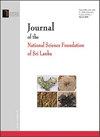Efficiency boost of inverted polymer solar cells using electrodeposited n-type Cu2O electrons selective transport layers (ESTLs)
IF 0.4
4区 综合性期刊
Q4 MULTIDISCIPLINARY SCIENCES
Journal of the National Science Foundation of Sri Lanka
Pub Date : 2023-06-30
DOI:10.4038/jnsfsr.v51i2.11230
引用次数: 0
Abstract
Polymer solar cells (PSCs) have attracted tremendous interest as suitable candidates for harnessing solar energy in the recent years. The inherent optoelectronic properties of the inorganic transition metal oxide, negative type cuprous oxide (n-Cu2O), makes it an attractive candidate to improve the performance of PSCs when incorporated as the electron selective transport layers (ESTLs) in the device. In this study, inverted PSCs were fabricated on stainless steel (SS) substrates with n-Cu2O as the ESTL. The n-Cu2O films were prepared by electrodeposition method, followed by annealing under ambient conditions. The active layer material was prepared as bulk heterojunction blend using regioregular poly(3-hexylthiophene) (P3HT) and phenyl-C61-butyric acid methyl ester (PCBM). Poly-(4,3-ethylene dioxythiophene):poly(styrenesulphonate) (PEDOT:PSS) was used as the hole transport layer (HTL) and the final device structure was SS/n-Cu2O/P3HT:PCBM/PEDOT:PSS/Au. Annealing of the n-Cu2O ESTL in air was optimized observing the photoactive performance of the device. Optoelectronic performance of the devices was characterized using spectral response and dark and light current-voltage (I-V) measurements. n-Cu2O ESTL- incorporated devices have absorbed more photons in the short wavelength region of 450‒600 nm with the annealing of n-Cu2O ESTL due to the reduction of electron-hole recombination. The performance of the devices was significantly increased after incorporating pre-annealed n-Cu2O ESTL at 175 °C for 30 min in air. The maximum power conversion efficiency (PCE) was 0.35%.使用电沉积n型Cu2O电子选择性传输层(ESTL)的倒置聚合物太阳能电池的效率提高
近年来,聚合物太阳能电池作为利用太阳能的合适候选者引起了人们的极大兴趣。无机过渡金属氧化物,负型氧化亚铜(n-Cu2O)的固有光电性质,使其成为在器件中作为电子选择性传输层(ESTL)引入时提高PSC性能的有吸引力的候选者。在本研究中,以n-Cu2O为ESTL,在不锈钢(SS)基底上制备了倒置PSCs。采用电沉积方法制备了n-Cu2O薄膜,然后在环境条件下退火。使用区域规则聚(3-己基噻吩)(P3HT)和苯基-C61-丁酸甲酯(PCBM)以本体异质结共混物的形式制备活性层材料。采用聚(4,3-乙烯二氧噻吩):聚(苯乙烯磺酸盐)(PEDOT:PSS)作为空穴传输层(HTL),最终器件结构为SS/n-Cu2O/P3HT:PCBM/PEDOT:PSS/Au。对n-Cu2O ESTL在空气中的退火进行了优化,观察了器件的光活性。使用光谱响应和明暗电流电压(I-V)测量来表征器件的光电性能。随着n-Cu2O ESTL的退火,由于电子-空穴复合的减少,掺入n-Cu2O-ESTL的器件在450-600nm的短波长区域吸收了更多的光子。在175°C的空气中加入预退火的n-Cu2O ESTL 30分钟后,器件的性能显著提高。最大功率转换效率(PCE)为0.35%。
本文章由计算机程序翻译,如有差异,请以英文原文为准。
求助全文
约1分钟内获得全文
求助全文
来源期刊

Journal of the National Science Foundation of Sri Lanka
MULTIDISCIPLINARY SCIENCES-
CiteScore
0.90
自引率
0.00%
发文量
57
审稿时长
>12 weeks
期刊介绍:
The Journal of National Science Foundation of Sri Lanka (JNSF) publishes the results of research in Science and Technology. The journal is released four times a year, in March, June, September and December. This journal contains Research Articles, Reviews, Research Communications and Correspondences.
Manuscripts submitted to the journal are accepted on the understanding that they will be reviewed prior to acceptance and that they have not been submitted for publication elsewhere.
 求助内容:
求助内容: 应助结果提醒方式:
应助结果提醒方式:


